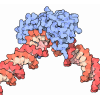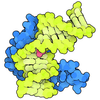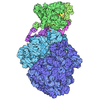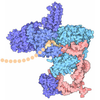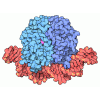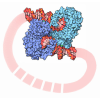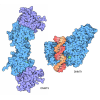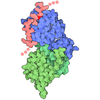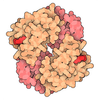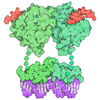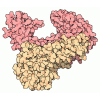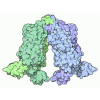+ Open data
Open data
- Basic information
Basic information
| Entry | Database: PDB / ID: 9hby | ||||||||||||||||||||||||||||||
|---|---|---|---|---|---|---|---|---|---|---|---|---|---|---|---|---|---|---|---|---|---|---|---|---|---|---|---|---|---|---|---|
| Title | TiLV-NP hexamer (pseudo-C6) (local refinement around 3 TiLV-NPs) | ||||||||||||||||||||||||||||||
 Components Components |
| ||||||||||||||||||||||||||||||
 Keywords Keywords | RNA BINDING PROTEIN / Viral protein / nucleoprotein / oligomer | ||||||||||||||||||||||||||||||
| Function / homology | DNA / DNA (> 10) / Uncharacterized protein Function and homology information Function and homology information | ||||||||||||||||||||||||||||||
| Biological species |  Tilapia lake virus Tilapia lake virus | ||||||||||||||||||||||||||||||
| Method | ELECTRON MICROSCOPY / single particle reconstruction / cryo EM / Resolution: 3.1 Å | ||||||||||||||||||||||||||||||
 Authors Authors | Arragain, B. / Cusack, S. | ||||||||||||||||||||||||||||||
| Funding support |  France, 1items France, 1items
| ||||||||||||||||||||||||||||||
 Citation Citation |  Journal: Nucleic Acids Res / Year: 2025 Journal: Nucleic Acids Res / Year: 2025Title: Structure of the tilapia lake virus nucleoprotein bound to RNA. Authors: Benoît Arragain / Martin Pelosse / Karine Huard / Stephen Cusack /  Abstract: Tilapia Lake virus (TiLV) belongs to the Amnoonviridae family within the Articulavirales order of segmented negative-strand RNA viruses and is highly diverged from more familiar orthomyxoviruses, ...Tilapia Lake virus (TiLV) belongs to the Amnoonviridae family within the Articulavirales order of segmented negative-strand RNA viruses and is highly diverged from more familiar orthomyxoviruses, such as influenza. The viral nucleoprotein (NP), a key component of the replication machinery, packages the viral genome into protective ribonucleoprotein particles. Here we describe the electron cryo-microscopy (cryo-EM) structure of TiLV-NP bound to RNA within in vitro reconstituted, small ring-like, pseudo-symmetrical oligomers. Although TiLV-NP is considerably smaller than its influenza counterpart and unrelated in sequence, it maintains the same topology and domain organisation. This comprises a head and body domain between which is a positively charged groove, where single-stranded RNA binds. In addition, an oligomerisation loop inserts into a hydrophobic pocket in the neighbouring NP, the flexible hinges of which allow variable orientation of adjacent NPs. Focused cryo-EM maps unambiguously define the 5' to 3' direction of the bound RNA, confirmed by double stranded, A-form RNA regions that extrude out from some of the NP-NP interfaces. This is the first fully resolved description of how single-stranded and stem-loop RNA binds to an articulaviral NP assembly. Superposition with orthomyxoviral NPs suggest that the mode of RNA binding is likely similar across the Articulavirales order. | ||||||||||||||||||||||||||||||
| History |
|
- Structure visualization
Structure visualization
| Structure viewer | Molecule:  Molmil Molmil Jmol/JSmol Jmol/JSmol |
|---|
- Downloads & links
Downloads & links
- Download
Download
| PDBx/mmCIF format |  9hby.cif.gz 9hby.cif.gz | 213.4 KB | Display |  PDBx/mmCIF format PDBx/mmCIF format |
|---|---|---|---|---|
| PDB format |  pdb9hby.ent.gz pdb9hby.ent.gz | 169.7 KB | Display |  PDB format PDB format |
| PDBx/mmJSON format |  9hby.json.gz 9hby.json.gz | Tree view |  PDBx/mmJSON format PDBx/mmJSON format | |
| Others |  Other downloads Other downloads |
-Validation report
| Summary document |  9hby_validation.pdf.gz 9hby_validation.pdf.gz | 409.1 KB | Display |  wwPDB validaton report wwPDB validaton report |
|---|---|---|---|---|
| Full document |  9hby_full_validation.pdf.gz 9hby_full_validation.pdf.gz | 419.6 KB | Display | |
| Data in XML |  9hby_validation.xml.gz 9hby_validation.xml.gz | 20 KB | Display | |
| Data in CIF |  9hby_validation.cif.gz 9hby_validation.cif.gz | 30.2 KB | Display | |
| Arichive directory |  https://data.pdbj.org/pub/pdb/validation_reports/hb/9hby https://data.pdbj.org/pub/pdb/validation_reports/hb/9hby ftp://data.pdbj.org/pub/pdb/validation_reports/hb/9hby ftp://data.pdbj.org/pub/pdb/validation_reports/hb/9hby | HTTPS FTP |
-Related structure data
| Related structure data |  52034MC  9hbrC 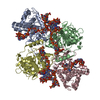 9hbsC  9hbtC  9hbuC  9hbvC  9hbwC  9hbxC  9hbzC M: map data used to model this data C: citing same article ( |
|---|---|
| Similar structure data | Similarity search - Function & homology  F&H Search F&H Search |
- Links
Links
- Assembly
Assembly
| Deposited unit | 
|
|---|---|
| 1 |
|
- Components
Components
| #1: Protein | Mass: 38387.129 Da / Num. of mol.: 4 Source method: isolated from a genetically manipulated source Source: (gene. exp.)  Tilapia lake virus / Production host: Tilapia lake virus / Production host:  Trichoplusia ni (cabbage looper) / References: UniProt: A0A1Y9SHW7 Trichoplusia ni (cabbage looper) / References: UniProt: A0A1Y9SHW7#2: DNA chain | Mass: 15714.807 Da / Num. of mol.: 3 / Source method: obtained synthetically Details: The RNA sequence (40-mer vRNA loop) is 5' - pGCA AAU CUU UCU CAC GUC CUG ACU UGU GAG UAA AAU UUG G - 3'. Due to the inability to precisely define bases, the exact nucleotide register remains ...Details: The RNA sequence (40-mer vRNA loop) is 5' - pGCA AAU CUU UCU CAC GUC CUG ACU UGU GAG UAA AAU UUG G - 3'. Due to the inability to precisely define bases, the exact nucleotide register remains elusive. Thus, in the modelling, generic purines (P5P) and generic pyrimidines (Y5P) were assigned based on apparent base size. Source: (synth.)  Tilapia lake virus Tilapia lake virusHas ligand of interest | Y | Has protein modification | N | |
|---|
-Experimental details
-Experiment
| Experiment | Method: ELECTRON MICROSCOPY |
|---|---|
| EM experiment | Aggregation state: PARTICLE / 3D reconstruction method: single particle reconstruction |
- Sample preparation
Sample preparation
| Component | Name: TiLV-NP bound to the 40-mer vRNA loop / Type: COMPLEX / Entity ID: all / Source: RECOMBINANT |
|---|---|
| Source (natural) | Organism:  Tilapia lake virus Tilapia lake virus |
| Source (recombinant) | Organism:  Trichoplusia ni (cabbage looper) Trichoplusia ni (cabbage looper) |
| Buffer solution | pH: 8 |
| Specimen | Embedding applied: NO / Shadowing applied: NO / Staining applied: NO / Vitrification applied: YES |
| Vitrification | Cryogen name: ETHANE |
- Electron microscopy imaging
Electron microscopy imaging
| Experimental equipment |  Model: Titan Krios / Image courtesy: FEI Company |
|---|---|
| Microscopy | Model: TFS KRIOS |
| Electron gun | Electron source:  FIELD EMISSION GUN / Accelerating voltage: 300 kV / Illumination mode: FLOOD BEAM FIELD EMISSION GUN / Accelerating voltage: 300 kV / Illumination mode: FLOOD BEAM |
| Electron lens | Mode: BRIGHT FIELD / Nominal defocus max: 2000 nm / Nominal defocus min: 800 nm |
| Image recording | Electron dose: 40 e/Å2 / Film or detector model: GATAN K3 BIOQUANTUM (6k x 4k) |
- Processing
Processing
| EM software |
| |||||||||||||||||||||||||||
|---|---|---|---|---|---|---|---|---|---|---|---|---|---|---|---|---|---|---|---|---|---|---|---|---|---|---|---|---|
| CTF correction | Type: PHASE FLIPPING AND AMPLITUDE CORRECTION | |||||||||||||||||||||||||||
| Symmetry | Point symmetry: C1 (asymmetric) | |||||||||||||||||||||||||||
| 3D reconstruction | Resolution: 3.1 Å / Resolution method: FSC 0.143 CUT-OFF / Num. of particles: 366980 / Symmetry type: POINT | |||||||||||||||||||||||||||
| Atomic model building | Space: REAL | |||||||||||||||||||||||||||
| Refine LS restraints |
|
 Movie
Movie Controller
Controller











 PDBj
PDBj